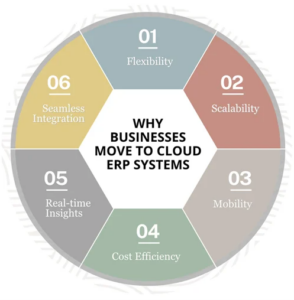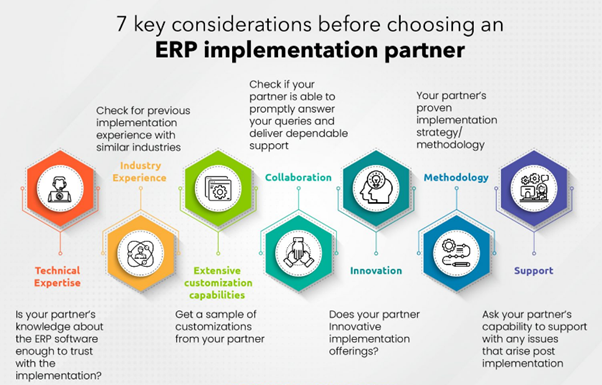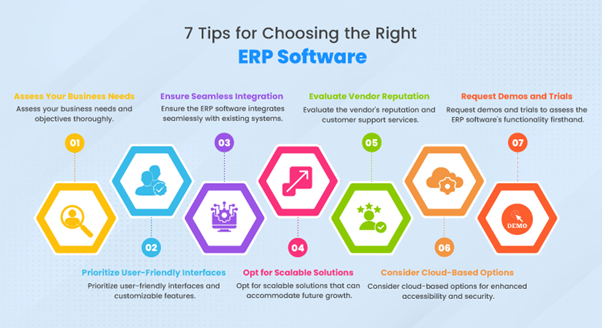How to Choose the Right ERP Software Solution: A Step-by-Step Guide
Every business is facing intense competition these days. It is crucial for businesses to succeed while ensuring controlled costs and a standardized process. Regardless of the shape and size of the companies, they are eager to have a custom ERP software solution for their business. There is no denying that legacy systems hinder growth. The right ERP software solution is crucial. Now, the question is, how do you determine the right one for your business? That’s what we are here to help you with. This blog shares a step-by-step guide to choosing the right ERP solution for your business.
ERP Software Solutions at a Glance
ERP software is an integrated and multifaceted business management system comprising modules for financial accounting, inventory management, manufacturer and customer order handling, and production planning. If an ERP software solution is used correctly, it helps streamline the complete operations of a business organization. Also, it helps in maintaining data consistency throughout all the departments. An ERP system is crucial for a complex business process, especially when focusing on internal activities.
Did you know? The ERP market was valued at $63.33 billion in 2022 and is projected to reach $187.79 billion by 2030. (Forbes)
Evolution of ERP with AI, Automation & Cloud
Currently, ERP software solutions are evolving. Integrating generative AI in ERP systems enhances various aspects, including financial operations, transactions, and manufacturing. AI improves financial analysis by detecting trends and anomalies. This helps with accurate budgeting and forecasting. Also, it optimizes the inventory every month. With predictive analytics, it is easy to maintain ideal stock levels.
When it comes to maintenance, AI predicts equipment servicing needs and reduces downtime. AI helps to improve HR functions with ERP software systems by analysing resumes and profiles to choose the best candidate. Also, it helps to forecast employee turnover and suggests training and strategies for career development. AI improves customer relations through interactions and engagement. For instance, AI can be used with ERP system data to ensure demand forecasting. This can guide the CRM in planning customized and targeted marketing campaigns.
Cloud ERP is a company management software used from a remote server. There are multiple ways to access the ERP software. It’s not restricted to a web browser or a mobile app. The best thing about cloud ERP is that users won’t need to invest in IT infrastructure or expensive hardware. Therefore, it is a cost-effective solution. Moreover, it is highly adaptable and scalable. Thus, it allows firms to change their functionality and capacity based on their changing needs while they grow.
One of the crucial statistics about implementing ERP software solutions is that 46% of businesses believe that cost savings is a “top 3” most important goal for ERP. (B1 Solutions)

Reasons Why Your Business Needs ERP Software Solutions
To implement an ERP software solution, it is crucial to have a significant investment. However, it has many benefits that can help improve, scale, and unify the business. Let us share the benefits of using ERP software for business.
1. Tracking IT Spending:
This is one of the best and most crucial aspects of ERP software. It is designed to unify the processes and workflows, which reduces the need for various systems. This offers you higher control and insight into the IT resource, ensuring higher cost savings and better efficiency.
2. Flexible Modules :
When you choose an ERP software vendor today, you shall have a lot of options. Therefore, you can buy a model based on the applications you need for your business. This modular approach not only helps to improve efficiency but also helps in managing costs.
3. Standardized Workflows:
Adding a singular system throughout all the departments will standardize the processes and workflows. This ensures a cross-term transparency. It is a unified approach that helps better collaboration and streamlines business processes, ensuring business growth.
4. Value-added Supply Chain Management:
It is crucial for businesses that depend on physical manufacturing and production workflows to streamline their supply chain. This is where the ERP software solution comes in. It helps to improve responsiveness, procurement, and inventory management.
5. Better Reporting:
ERP ensures better visibility and insights with unified business systems. This helps in improving the reports and long-term planning. When you have complete clarity on how and where the resource is used, you can add quantified changes that benefit the process and the overall bottom line.
Did you know? Manufacturers are the largest group of ERP system buyers! 47% of manufacturers buy ERP software systems, followed by distributors at 18%. (Forbes)
Factors to Consider While Choosing the Right ERP Software
When you start sorting out ERP vendors, it is crucial to know what to look for and what to avoid. Different systems have different specifications. When you have a checklist of all the requirements, it will help with the ERP selection. Here are seven things to consider.
1. Functionality :
Think about what you need from the ERP system and the functionalities that can help you achieve them. Gathering the requirements is crucial to choosing the right ERP software. This will ensure that your business needs align with the functions of a specific system.
2. Ease of Use :
This is another question you must think of while choosing an ERP software solution. How easily can you start using the software? What are the features it is offering to ease day-to-day use? The ERP system must be intuitive and easy to use at every level of the business.
3. Vendor Reputation and Security :
If you are planning to invest in ERP software, know that it is a long-term partnership with the specific vendor. Verify how reputable and secure they are. Check the reviews and seek impartial advice. Think about the business credentials before choosing a specific vendor.
4. Technology :
What are the features and technologies required for your business from the ERP suite? Is the vendor able to offer them? The typical features of ERP system include:
a. Customizable features along with modular flexibility –Can you tailor the system to align with the goals and objectives? How easy is it to implement such changes? Consider these factors when choosing an ERP system.
b. Business-wide integration – Can you easily implement the system in all departments throughout your business? What are the benefits and changes it will mean for the core areas of the operation?
c. Real-time functions and operations – Can you check all the functionalities in real time and make adjustments according to your requirements, errors, or opportunities?
d. A unified interface – It is crucial to have a consistent look and feel. This helps with collaboration and ensures that the system is easily accessible on all levels of the business.
5. Implementation:
How easy is it to implement the overall process? How soon can you expect all the system tools and features to be up and running? When you choose a smooth implementation process, you will see the benefits of the system soon, which will help you increase ROI. Make sure to inquire regarding the help you can expect during the implementation, along with the in-house resources needed throughout the process of migrating the old systems and data.
6. Training and Support :
Will the vendor offer training to help the in-house resources easily understand the system’s tools and features? What kind of help and support should you expect from the vendor for the day-to-day operation of the software?
Do you know why it is crucial to ensure proper training and support for the in-house resources while implementing ERP software solutions? 82% of individual users show reluctance and resistance to the new ERP software (Forbes). This is one of the most important factors why the in-house employees of a business organization should be properly trained on the latest ERP software.
7. Cost :
This is one of the most important aspects of assessing the viability and ROI of an ERP system. Think of the following regarding the pricing of the individual software:
a. Upfront pricing – Before you start to discuss with the vendors, you have to get an idea of the upfront cost that you can expect. You are trying to get a basic price for the system implementation. However, keep in mind that there shall be other ongoing costs. When you have a basic idea of the cost, you can decide which vendors to approach and what services are within the ballpark.
b. The real cost – The “real cost” of an ERP software solution is the long-term cost of acquisition and use. This will also include the basic implementation cost, the long-term total cost, and associated licensing, training, maintenance, support, and hosting fees.
Here is an interesting fact on why it is crucial to be aware of the cost and ensure complete transparency. 45% of ERP implementations in business organizations are affected by budget overruns. Most companies aim to complete the process in a year, but only 49% finish the implementation on schedule (Forbes).

Source – Demand Dynamics
Step-by-step Guide in Choosing the Right ERP Software
Selecting an ERP software solution is a daunting task. There are a lot of things to know before you finalize one for your business. To get things right, here are four simple steps to guide you through choosing the right ERP software. This will help you be absolutely sure that all the bases are covered.
Step 1 – Gathering the Requirements
This is the first stage of ERP software selection. As we mentioned earlier, it is crucial to be clear about your business needs and the features of the ERP system needed to meet them. Let us elaborate on that. Ask the following questions.
a) What are the limitations of the current systems, and what are the features that would help fill the gaps and improve efficiency?
b) What technologies are needed by individual departments? Create a “wish list” of the features for every area. Cross-check them with the available vendor applications later on.
c) Get an honest overview of the perceived business weakness from the senior-level personnel. The insights will help choose the modules and applications throughout the implementation stage.
d) What are the transformations that you would want to see across the business as it grows? Think about how the ERP system can help you achieve the key business goals and objectives.
Step – 2 – Comparing the Vendors
When you have the checklist of requirements, it is time to start the process of comparing ERP software vendors. You must be careful about the requirements and the seven key factors listed above. Only then can you begin to create the list of your vendors. As a reminder, here is a list of items to clarify with the vendors while assessing their feasibility.
a) Do their features and products meet the technological and support requirements?
b) Do the vendor applications match with the legacy systems? How will the implementation affect the data storage and migration?
c) Does the vendor have experience and knowledge of the industry? Are they able to offer any specialist tools or expertise that are tailored to your sector?
Step 3 – Check Demos, Evidence, and Proof of Concept
When you have shortlisted a few vendors and gone through a few preliminary discussions, it is time to seek proof of concept. Is the vendor capable of delivering the experience that you want while also meeting your business needs and objectives? There are multiple ways that a vendor can show that they can meet your business requirements. Here are the things to check:
a) Detailed product demos
b) A customized technical demonstration regarding their service and how it benefits your organization
c) Testing the specific features and applications to ensure that the feasibility and sustainability
Step 4: Final Checks and Considerations
Finally, before you sign the dotted line, you have to make the right decision. Here are some final checks that will help you to ensure when it is time to seal the deal:
a) The final viability: This is when you are aware of the actual cost of the ERP system that you plan to integrate. Thus, crunch the numbers one last time and make sure that you have considered everything.
b) Departmental suitability: Meet with all the senior-level staff and the key stakeholders to know everyone’s take on the ERP system that will be implemented. Consider their opinions and make sure everyone is happy to proceed with the implementation.
c) Contracts and terms: When you get into an agreement, there will be certain terms and conditions. Are you happy with the terms, and do they meet your expectations? This is why the negotiation stage is so critical. It ensures the long-term success of the partnership between you and the ERP system vendor.
Did you know? 83% of the organizations achieve their expected ROI within their time frame after implementing the ERP system. (Retain International)

Source – Nevas Technologies
Challenges in Implementing ERP System in Your Business
Once you decide to implement an ERP software solution to your business, you must know that it comes with certain challenges. In the following section of the blog, we will share the obstacles and challenges that you might come across.
Challenges of Implementing ERP System Software and How to Overcome Them
Implementing an Enterprise Resource Planning (ERP) system is crucial for any organization. It often comes with its own set of challenges and obstacles. However, with proper planning and strategy, you can overcome these difficulties, ensuring a smooth transition and long-term success.
-
Resistance to Change
One of the most common challenges when implementing an ERP system is resistance from employees. Employees may be reluctant to adopt new systems due to fear of change, lack of understanding, or comfort with existing processes.
How to Overcome:
a. Training and education: Ensure thorough training for all staff members to make them familiar with the new system.
b. Involve employees early: Engage employees in the process from the beginning to create ownership and reduce anxiety.
c. Communicate benefits: Highlight the new system’s advantages, such as improved efficiency and reduced manual tasks.
-
Data Migration Issues
Migrating data from legacy systems to the new ERP software can be complex and time-consuming. Incorrect or incomplete data migration can cause issues post-implementation.
How to Overcome:
a. Pre-planning: Conduct a thorough audit of existing data before migration and cleanse the data to ensure accuracy.
b. Phased approach: Implement the data migration in phases, testing the system at each step to ensure accuracy.
Backup plans: Always have a backup plan in case of migration issues to avoid data loss.
As we are talking about phased approaches, here is a unique fact: More than 50% of business organizations choose the phased approach to implement ERP systems. (Netsuite)
-
Customization and Integration Complexities
ERP systems need to be customized to suit an organization’s specific needs, and integration with other existing systems (e.g., CRM, supply chain, etc.) can be challenging.
How to Overcome:
a. Choose the right ERP system: Select an ERP system that offers flexibility and scalability to cater to your unique business requirements.
b. Involve stakeholders: Engage with internal departments to understand their specific needs and customize accordingly.
c. Work with experienced vendors: Collaborate with ERP vendors who have experience with integration and customization and ensure they provide support during and after implementation.
-
Budget and Resource Constraints
Implementing an ERP system can be expensive, with costs associated with the software, hardware, training, and potential downtime. Staying within budget is sometimes a challenge, especially for smaller organizations.
How to overcome:
a. Set realistic budgets: Establish a clear budget from the start and plan for contingencies.
b. Cost-benefit analysis: Perform a detailed cost-benefit analysis to ensure that the long-term benefits outweigh the initial investment.
c. Phased implementation: Consider a phased rollout to manage costs over time, starting with the most critical modules and expanding gradually.
-
Lack of Executive Support
Without strong support from top-level management, ERP implementation can fail due to a lack of direction, resources, or commitment.
How to Overcome:
a. Secure executive buy-in early: Ensure that executives understand the strategic importance of ERP software solutions and are involved from the beginning.
b. Regular updates: Keep leadership updated on progress, challenges, and successes throughout the implementation process.
c. Define clear objectives: Set goals and KPIs for the ERP project that align with organizational strategy.
-
Post-implementation Maintenance and Support
Maintenance and support issues can arise, such as software bugs, system upgrades, or ongoing training needs, even after the system is live.
How to Overcome:
a. Develop a support plan: Create a post-implementation plan, including regular system updates, troubleshooting, and user support.
b. Dedicated support team: Designate a team or person responsible for ERP system maintenance and user issues.
c. Continuous training: Provide ongoing training and resources for employees to help them fully utilize the system’s capabilities.
According to Retain International, the primary areas where the ERP system helps to improve ROI include reduced IT costs (40%), decreased inventory levels (38%), and shorter cycle times (35%).
In Conclusion
Choosing the right ERP software solution is a critical decision that can improve efficiency and ensure the success of your business operations. Following a step-by-step guide, you can ensure your organization selects a system that meets your unique needs.
Start by thoroughly understanding your company’s requirements, from functionality to scalability. Carefully evaluate ERP vendors based on cost, implementation support, and user experience. Engage key stakeholders, ensure the software is customizable and integrates with existing systems, and don’t forget to prioritize user training and post-implementation support.








